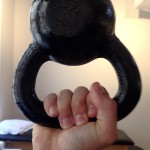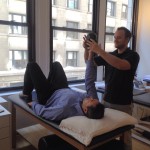Shoulder patients can be difficult, especially when it comes to strengthening. Some are too flared up and don’t have the right mechanics to initiate basic isotonic strengthening. Others can’t seem to get the right muscle firing sequence for optimal functional movements. And some are just so weak in their entire upper quarter that they can’t tolerate much exercise at all. It often becomes difficult to determine where to start and how to progress. One answer to this difficult question lies distally in the hand. The simple task of gripping can have a great influence on the shoulder. Not only has it been shown to improve rotator cuff (RTC) activity (1-6), but it may have an important role in injury prevention and recovery.
The Grip-Shoulder Connection
Here are 6 ways the grip can influence the shoulder.
1) Neurological Connection of the Grip and the Rotator Cuff
Many studies have shown a positive correlation between hand gripping activity and rotator cuff muscle activity (2-6). This correlation has been shown to be a result of a neurological connection through propriospinal pathways (1). An advantage of this mechanism is that it provides the shoulder with anticipatory stability in upper extremity tasks involving a gripping activity. Thus, upon manipulating an object your shoulder will be better prepared to handle the load efficiently.
2) Redistributes Muscle Activity of the Shoulder
Not only does gripping help to activate the RTC, but it decreases the activity of the anterior and middle deltoid (2,3,5,6). Most shoulder impingement patients suffer from an altered deltoid-RTC force couple where the deltoid’s superior force dominates the compressive, centrating forces of the RTC. Since gripping can increase RTC activity and decrease deltoid activity, it can be a very valuable exercise for impingement patients.
3) Irradiation
Irradiation has proven to be of great benefit in improving stability. Irradiation has been defined as “a spreading and increased strength of a response.”(7) Gripping can be used to increase the flow of neural drive to all of the muscles in the extremity. This can lead to increased stability and strength of the entire upper quarter.
4) Muscle Pump
For inflamed shoulders or shoulders that could benefit from increased blood flow and improved venous return, grip work provides a muscle pump similar to that of ankle pumps for knee patients.
5) Prevents Mechanical Compensation
Similar to pronation causing a proximal dynamic valgus in the lower extremity, a weak grip can cause proximal compensatory mechanisms in the elbow, shoulder, and/or cervical spine. A lack of stability in one segment will always be made up for by another.
6) Improves Grip Strength
Even at a local level, improving grip strength provides many benefits. A stronger grip can help to improve wrist function and may prevent injuries. This increased grip strength can make functional tasks such as carrying groceries, opening jars, and lifting objects much easier.
Assessment
Assessing hand grip strength can either be objective, or clinically judged. Either way, you should try to establish a baseline level of grip strength and function before developing a treatment plan. It’s important to assess both sides, but keep in mind that handedness will bias the results.
Hand-Dynamometer
A handheld dynamometer can give an exact number that you can measure bilaterally and re-assess later in treatment. The objectivity of this test makes it easy for the therapist to determine grip strength. The downside is that they’re expensive and maximal grip strength in a seated position of neutral shoulder isn’t very functional. The patient may also have a difficult time understanding why their maximal grip matters when it’s their shoulder that hurts.
Bottoms-Up Kettlebell
This mechanism is very similar to assessing and treating lower extremity stability by looking at barefoot single leg stance (large COM above small BOS).
This kettlebell (KB) test is the blue-collar way to assess grip. Place the patient in hooklying, have them flex their arm to 90 degrees, and place a light KB in their hand in the bottoms-up position. The scapula should be in a neutral position and not protracted; this is not a serratus anterior manual muscle test.
Make sure to guard the KB to comfort the patient and provide support in case the patient begins to lose their grip. Have them hold it for 10-20 seconds and assess the aberrant motion throughout the extremity. Progress the weight of the KB until you find a weight that is difficult for them to stabilize.
This test is easy to perform, functional, and provides great information regarding upper extremity stability and grip strength. Plus, it gives the patient a kinesthetic sense of their instability.
Why a Kettlebell?
 The bottoms-up kettlebell is unstable by nature (large COM above a small BOS). With the wrist and elbow joint locked in neutral, the unstable KB force is transferred proximally to the shoulder. This KB instability coupled with the handle grasp strengthens the grip and stabilizes the shoulder.
The bottoms-up kettlebell is unstable by nature (large COM above a small BOS). With the wrist and elbow joint locked in neutral, the unstable KB force is transferred proximally to the shoulder. This KB instability coupled with the handle grasp strengthens the grip and stabilizes the shoulder.
With a KB you can also modify the stability demands in different shoulder positions to match your patients specific impairment. For example, if a patient comes in with only shoulder pain when hitting a tennis serve, you can assess the bottoms-up KB in the overhead position. Or if a patient has pain reaching out to the side, you can assess bottoms-up KB in sidelying with the shoulder at 90 degrees of abduction.
Intervention
Once you understand the concept of grip strength and it’s influence on the shoulder, you can use it in an infinite amount of ways. Even if you don’t have kettlebells, you can simply use a towel, low compression tennis ball, or thera-bar (really anything you can grip circumferentially).
If you do have kettlebells, then door opens up to many different exercise progressions. But before you get carried away with turkish get-ups, partial arm-bars, KB carries, waiters walks, and bottoms-up presses, you should start slow and develop the grip strength first.
Basic Grip-Shoulder Stability Exercise
Hooklying KB Bottoms-Up Hold (in 90 degrees of shoulder flexion)
The good thing about having a functional assessment is that it becomes the intervention. Find the appropriate load for your patient and let them struggle in this position for 20 seconds. Since it is a natural neuromuscular response, you simply need to apply the right load and let the nervous system work itself out.
Once the patient becomes proficient at this exercise it can be used as a warm-up prior to more advanced exercises.
Conclusion
Grip strengthening offers an easy way to augment shoulder stability. There are many benefits from simply adding a gripping activity to upper extremity exercises. It’s easy to both assess and implement.
For low level patients the supine bottoms-up KB exercise offers a challenge that can activate the right muscle sequencing and improve stability. For more advanced patients it becomes a great warm up that can be integrated into more functional dynamic exercises.
References
- Roberts LV, Stinear CM, Lewis GN, and Byblow WD. “Task-Dependent Modulation of Propriospinal Inputs to Human Shoulder.” Journal of Neurophysiology 100.4 (2008): 2109-114.
- Sporrong H, Palmerud G, Herberts P. Influences of handgrip on shoulder muscle activity. Eur J Appl Physiol Occupat Physiol 71: 485–492, 1995.
- Sporrong H, Palmerud G, Herberts P. Hand grip increases shoulder muscle activity: an EMG analysis with static hand contractions in 9 subjects. Acta Orthop Scand 67: 485–490, 1996.
- Sporrong H, Styf J. Effects of isokinetic muscle activity on pressure in the supraspinatus muscle and shoulder torque. J Orthop Res 17: 546 –553, 1999.
- Au AK, Keir PJ. Interfering effects of multitasking on muscle activity in the upper extremity. J Electromyogr Kinesiol 2007;17:578–86.
- Antony NT, Keir PJ. Effects of Posture, Movement and Hand Load on Shoulder Muscle Activity. Journal of Electromyography and Kinesiology 20.2: 191-98. 2010.
- Adler S, Beckers D, and Buck M. PNF in Practice: An Illustrated Guide. Berlin: Springer, 2000.
